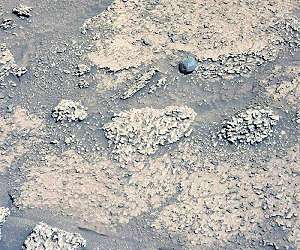Minerals are like a time capsule; they provide a record of what the environment was like at the time they formed. Different minerals are linked to different kinds of environments. The temperature, pressure, and chemical ingredients that were present – including water – determine what minerals form and how they are altered.
For example, gypsum is a mineral that contains calcium, sulfur, and water. Anhydrite is a mineral that contains calcium and sulfur, but no water. The Chemistry and Mineralogy (CheMin) instrument aboard the Mars Science Laboratory (MSL) Curiosity rover is able to distinguish the two.
Some minerals detectable by CheMin – such as clay minerals, phosphates, carbonates, sulfates and silica – can help preserve biosignatures, or evidence of life. Under some conditions, clay minerals or minerals that form when salty water evaporates can encase and preserve these clues. Scientists use CheMin to search for these and other minerals that preserve evidence of a past Martian environment that might have supported microbial life (though Curiosity can’t determine whether signs of any life are present).
CheMin identifies the minerals in samples of finely powdered rock or soil using a technique called X-ray diffraction. William Henry Bragg and Lawrence Bragg, father and son, formulated the “Bragg equation” to explain the relationships between an incoming X-ray beam and the pattern of outgoing beams created when it interacts with a sample.
For example, a powdered crystalline sample will form a pattern of nested cones of light around a central transmitted beam, making them appear as concentric rings. Scientists can use the angular relationships of light and the Bragg equation to figure out the spaces between the atoms in a mineral. These spacings help identify which mineral – or minerals – produced the pattern from a soil or rock sample. X-ray diffraction has been the “gold standard” for mineral identification since its discovery…more than one hundred years ago.
Curiosity’s robotic arm delivers powdered rock or scooped soil to CheMin’s input funnel. Then CheMin – the first X-ray diffraction instrument ever sent to another planet – directs a beam of X-rays as fine as a human hair through the sample, which contains up to 85 mg – as much material as in a baby aspirin. A sample wheel mounted between the X-ray source and detector holds 32 disc-shaped cells, each about the diameter of a shirt button (8 mm) and about the thickness of a business card (0.2 mm).
The sample is held loosely between thin plastic windows and shaken to move the sample grains through the beam. Five cells hold samples from Earth to calibrate the instrument. The other 27 cells are for Martian samples and can be filled, analyzed, and emptied several times. An electronic imager called a charge-coupled device, similar to those found in digital cameras, collects the diffracted X-ray beams from the sample. Each sample is analyzed for 10 to 30 hours, spread over multiple nights.
As of December 2022, Curiosity has analyzed 42 samples of soil and rock as it traveled more than 18 miles (29 km) exploring Gale Crater, a large 100 mile (155 km) wide and three miles (5 km) deep crater near the equator. Scientists believe it once contained streams and lakes, as many as four billion years ago, when water flowed on the Martian surface. Sediment deposited in these ancient lakes may hold clues as to whether the environment once was habitable.
The CheMin instrument directly addresses one of the key objectives of the Mars Science Laboratory mission by seeking to identify and characterize past or present habitable environments as recorded in the chemical and mineralogical composition of sediments and rocks.
Additional details on key milstones and the many researchers involved along with science papers and more can be found here
Related Links
CheMin Database
CheMin for Scientists
Mars News and Information at MarsDaily.com
Lunar Dreams and more
|
We need your help. The SpaceDaily news network continues to grow but revenues have never been harder to maintain. With the rise of Ad Blockers, and Facebook – our traditional revenue sources via quality network advertising continues to decline. And unlike so many other news sites, we don’t have a paywall – with those annoying usernames and passwords. Our news coverage takes time and effort to publish 365 days a year. If you find our news sites informative and useful then please consider becoming a regular supporter or for now make a one off contribution. |
||
|
SpaceDaily Contributor $5 Billed Once credit card or paypal |
SpaceDaily Monthly Supporter $5 Billed Monthly paypal only |
|

![]()
In search of a new marker band drill site: Sols 3708-3709
Pasadena CA (JPL) Jan 12, 2023
We continue to characterize the Marker Band and the bedrock just below it, with the aim of understanding the origin of the Marker Band. For today’s two-sol plan, in an area below the Marker Band, we planned early morning APXS and MAHLI (Touch and Go) on the brushed target “Jenipapo,” similar to the flattest material in the accompanying Mastcam image.
Mastcam will acquire some multi-spectral imaging on the same target, and on the target “Pau Baru,” seen in the upper right of the Mastcam image. This … read more